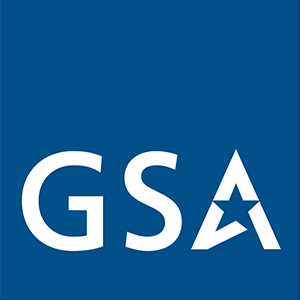Introduction
Within This Page
Growing demand for mid-rise buildings, including apartments and condominiums, senior living, affordable, and mixed-use commercial/residential developments, creates both challenge and opportunity for building professionals as they work to balance value with performance. Wood-frame construction is a cost-effective option for mid-rise structures because it allows high density (five stories for many residential occupancy groups, six for office) at relatively low cost, while providing other benefits such as construction speed, structural performance, design versatility, and a sustainable, low-carbon footprint.i
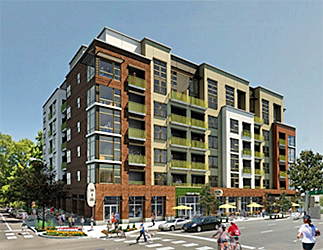
16 Powerhouse Street, Sacramento, CA Photo credit: D&S Development
More than with other types of construction, the structural detailing of mid-rise wood buildings plays a large role in the ability to manage investment costs per unit and maximize the lot configuration. This paper focuses on how to achieve maximum value for a variety of wood-frame mid-rise building types. It explores the density potential of different multi-story configurations, beginning with a discussion of heights and area increases allowed through provisions of the 2012 International Building Code (IBC).ii A number of common structural design challenges are also considered, including those related to fire safety, shrinkage, and constructability.
Common Multi-Story Configurations
Multi-story mixed-use and multi-residential projects are usually configured in one of three ways:
- Tuck-under/walk-up
- Wrap-around
- Podium
Each configuration offers advantages, and each can be used to achieve a different level of density. However, each also has unique requirements in terms of its structural design and detailing.
Tuck-Under/Walk-Up
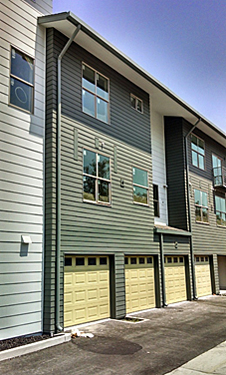
Tuck-Under Design Photo credit: Scott Breneman
Tuck-under units with private parking garages are common in suburban residential settings where high density is not a priority. Typically three stories, this configuration achieves the lowest densification rate, but is also the least expensive. Construction costs are kept low because there is minimal excavation; there is no need for a central parking garage, and the entire structure is typically built using one type of framing material—wood.
There is a growing trend in some urban areas (driven by sustainability goals) to eliminate parking altogether. Known as a walk-up configuration, this variation replaces parking with additional units on the ground floor.
Wrap-Around
The wrap-around configuration (also known as the 'Texas donut') consists of a centralized multi-story concrete parking structure surrounded by multiple stories of wood-frame units built from the ground up. This configuration provides accessible parking for occupants as well as security and visual appeal, since the parking structure can't be easily accessed from outside the development or seen from the street.
According to architect Tim Smith of Togawa Smith Martin Inc., who specializes in multi-story building design, five-story wrap-around structures can accommodate 60 to 80 units per acre, offering builders who use wood framing, a cost-effective option for large urban or suburban sites. Overall, this style is more expensive than tuck-under/walk-up, in part because the concrete parking structure adds cost and requires more time to construct.
Podium
Podium construction—also known as pedestal or platform construction—typically includes multiple stories of light framing over a single- or multi-story podium of another construction style, which may include retail as well as above- or below-grade parking levels. Concrete podiums are the most common, though steel podiums also exist. Although not considered 'podiums' under the IBC, using a heavy timber system to separate parking from light wood-frame residential units above is also gaining popularity.
The upper slab of a concrete podium typically acts as both a fire separation and structural transfer slab for the framing above. If built using the special provisions of IBC 510.2, this construction approach allows increased density with additional stories, maximizing the use of smaller urban lots while benefitting from wood-frame cost and speed of construction advantages.
Common configurations include four or five stories of residential use over retail, commercial, office and/or parking, and six or even seven stories of residential use, including the podium level(s), with subterranean parking. According to Tim Smith, four stories of residential occupancy over a non-residential podium will achieve densities similar to wrap-around. With five stories of residential units, density can increase to 100 to 120 units per acre. An additional 20 units per acre are achievable when the podium levels include residential occupancy.
Density can be increased even further with a mezzanine, which provides additional unit square footage, allowing potential for more units. Mezzanines are popularly used in upper floor units and can add an additional five units per acre. Creative architects have been known to get as many as 165 units per acre from podium construction by also manipulating grade to incorporate daylight basements or pursuing two full levels of above-ground podium. (This is explicitly allowed under the 2015 IBC. Under the 2012 IBC, it must be achieved through an alternate means and methods request but is not uncommon in certain parts of the country.) In a presentation given at the 2013 American Institute of Architects conference, Smith said this level of density competes with Type I structures of 10 and 11 stories, but at roughly one-third the cost per square foot.
Definitions and Occupancy
Much has been written about mid-rise construction, but what exactly does 'mid-rise' mean? A mid-rise building can be described as something between a high-rise and low-rise structure—that is, between four and ten stories. IBC Section 202 defines a high-rise structure as "A building with an occupied floor located more than 75 feet above the lowest level of fire department vehicle access." Code commentary clarifies that the critical measurement is from the lowest ground elevation to the top of the finished floor of the uppermost occupied level. A generally-accepted description of a low-rise structure is three stories and/or 35 feet tall. If a typical floor-to-floor height of 10 feet is assumed, then a mid-rise building would be between four and ten stories, or 35 to 85 feet tall.
Much of the growth in wood-frame mid-rise construction is focused on multi-residential and mixed-use applications that include residential with some retail or office space on the street level. While other occupancies are allowed and increasingly built using mid-rise techniques, this paper focuses on multi-residential because it is the most common occupancy group.
Occupancies Common mid-rise occupancies:
These occupancies are often mixed with other non-residential occupancies such as:
|
Heights and Areas
Utilizing code provisions to go beyond the base heights and areas permitted for mid-rise wood-frame buildings is key to maximizing value.
Base Tabular Amounts
Multi-story wood construction generally falls under construction Types III and V. Each building type is further subdivided into A and B, which have different fire-resistance rating requirements (A being more rigorous). Type IV construction, also known as Heavy Timber construction, can also be used for mid-rise structures, but this type limits the use of concealed spaces and therefore requires more creativity to meet acoustic goals and conceal utilities.
A wood building categorized as Type III-A construction is very similar to one of Type V-A construction in practice, with two notable exceptions. Where a designer wants to use wood for exterior walls, it must be fire retardant-treated (FRT) wood, and exterior bearing walls must be two-hour fire resistance-rated. These requirements are described in more detail below under Fire Life Safety Design Considerations.
IBC Table 503 lists allowable building heights and floor areas for different construction types. For example, Type III-A residential construction allows a building of up to four stories and 65 feet in height, while Type V-A construction allows three stories and 50 feet in height.
In the Pacific Northwest and Canada, some local codes allow up to six stories for residential wood-frame buildings without requiring FRT framing.
Increasing Building Size
There are numerous opportunities within the 2012 IBC to increase the size of wood buildings.
Chapter 9 addresses fire protection systems and requires all new Group R fire areas to be equipped with an automatic sprinkler system designed and installed per National Fire Protection Association (NFPA) 13, Standard for the Installation of Sprinkler Systems or NFPA 13R, Standard for the Installation of Sprinkler Systems in Low-Rise Residential Occupancies. Per IBC Section 504.2, use of an NFPA 13-compliant sprinkler system allows an increase in height of one story and 20 feet.
IBC Section 504.2 states, "... for Group R buildings equipped throughout with an approved automatic sprinkler system in accordance with Section 903.3.1.2, the value specified in Table 503 for maximum building height is increased by 20 feet (6,096 mm) and the maximum number of stories is increased by one, but shall not exceed 60 feet (18,288 mm) or four stories, respectively." This section is commonly misunderstood to imply that all R occupancies are limited to four stories and 60 feet in height. However, the sprinkler system being referenced by 903.3.1.2 is an NFPA 13R sprinkler system. If an NFPA 13 system is used, the 20 feet and one-story increase is allowed, even for Group R occupancies. Local amendments may apply.
In addition to increasing the allowable height, sprinklers can also be used per IBC Section 506.3 to expand the allowable floor area for a mid-rise building by an additional three times the tabulated area. Having open space (or frontage), per IBC Section 506.2, also contributes to a greater allowable floor area, though to a smaller degree. For buildings over three stories in height, the limiting factor is usually the maximum building square footage, not the maximum floor area square footage.

For example, IBC Table 503 states the base tabular floor area for Type V-A buildings with R-1 or R-2 occupancies is 12,000 square feet per story. However, if the design also meets requirements for provisions allowing the maximum increases based on sprinklers and open frontage, designers are allowed up to 45,000 square feet. For Type III-A buildings, a tabulated area of 24,000 square feet could be increased up to 90,000 square feet per story. These allowable increases give building designers a great deal of flexibility in terms of building mid-rise wood-frame structures.
IBC Equation 5-1: Aa = At + At (Is + If) Is (sprinkler increase) = 2 for buildings with 1 or more story If (frontage increase) = .75 maximum At (tabulated area) = value in Table 503 Aa (allowable floor area) Aa max = At +2At +.75At = 3.75At
TABLE 1
| Maximum Building Heights and Stories by Building Type with NFPA 13 Sprinklers | ||||
|---|---|---|---|---|
| Occupancy | III-A | III-B | V-A | V-B |
| 85 ft | 75 ft | 70 ft | 60 ft | |
| R-1/R-2/R-4 | 5 | 5 | 4 | 3 |
| A-2/A-3 | 4 | 3 | 3 | 2 |
| B | 6 | 4 | 4 | 3 |
| M | 5 | 3 | 4 | 2 |
| S-2 | 5 | 4 | 5 | 3 |
| S-1 | 4 | 3 | 4 | 2 |
While floor areas can be greatly increased, it is important for designers to recognize that there are limits to the overall square footage of the building. Sections 506.4.1 for single occupancy and 506.5.2 for mixed occupancy generally stipulate that buildings over three stories are limited to an overall building square footage (the sum of all floors) of three times allowable floor area. Four- and five-story buildings would therefore not be allowed to have all stories at the maximum allowable floor area. Assuming a single occupancy building over three stories, Table 2 shows the maximum sum of all floor areas.
TABLE 2
| Maximum Building Area Allowance (square feet) with NFPA 13 Sprinklers1 | ||||
|---|---|---|---|---|
| Occupancy | III-A | III-B | V-A | |
| R-1/R-2/R-4 | 216,000 | 144,000 | 108,000 | |
| A-2/A-3 | 126,000 | 85,5002 | 103,5002 | |
| B | 256,500 | 171,000 | 162,000 | |
| M | 166,500 | 112,5002 | 126,000 | |
| S-2 | 351,000 | 234,000 | 189,000 | |
| S-1 | 234,000 | 157,5002 | 126,000 | |
1Assumes three stories or more and an NFPA 13-compliant sprinkler system throughout with no frontage incrase. 2The maximum number of stories for these occupancies is three with an NFPA 13 sprinkler system.
For Type III and Type V buildings, an additional level can be added by designing a mezzanine into the project. IBC Section 505 indicates that a mezzanine can be up to one third of the floor area of the room or space where it is located and must be open to the room below. It is not considered a story, nor is it counted in the allowable floor area per IBC Chapter 5. However, the mezzanine area may be considered part of the fire area in Chapter 9 when designing fire protection systems. Mezzanines offer a way to increase the size of a structure—adding another 'virtual floor'—and are well-suited for residential occupancies.
In addition to building code requirements, it is important to be aware of the requirements in ASCE 7-10 Table 12.2.-1 relating to height limitations for light-frame wood shear wall structures. In Seismic Design Categories D, E and F, light-frame wood shear wall structures are limited to 65 feet in height. However, if a wood-frame-over-podium design qualifies for two-stage seismic analysis following ASCE 7-10 Section 12.2.3.2, the height of the light-frame wood shear wall structure can be measured from the top of the podium.
Special Provisions for Podium Designs
For podium configurations, designers can take advantage of several additional opportunities.
Podiums are a product of the horizontal building separation provision (IBC Section 510.2). Separated by a three-hour fire resistance-rated horizontal assembly, these 'four-over-one' and 'five-over-one' podium-style buildings are treated in the code as two separate structures built one on top of the other for the purpose of determining area limitations, continuity of fire walls, allowable number of stories, and type of construction.
For the podium to be considered as a separate and distinct building with regard to determining height and area limitations and for allowing a break in vertical continuity of fire walls, it must have an NFPA 13 sprinkler system. All elevator and stair shafts through the horizontal building separation must be two-hour rated and occupancies above and below the podium are permitted to be A, B, M, R or S. The overall height of the two buildings together is measured from grade plane, and is limited by the provisions of Chapter 5 (with increases) for the more restrictive of the two buildings, which in these cases would be the upper Type V or Type III building. The 2015 IBC expands this opportunity by allowing podiums to include two or more stories below the three-hour horizontal fire assembly with the caveat that the overall building height above grade (from grade plane to the average of the highest roof plane) must still not exceed the limits set in Chapter 5 for the more restrictive of the two buildings.
The second relevant special provision, covered in IBC Section 510.4, is not used with the same frequency as the 510.2 horizontal building separation allowance provision but offers a similar opportunity for stacking buildings and gaining the ability to add an additional floor. Specifically for buildings with parking below (S-2 occupancy) and any Group R occupancy above, this provision allows a podium of Type I or Type IV construction but only requires a two-hour fire separation that can be further reduced to a one-hour separation if sprinklered per Table 508.4. The height is again limited to that of the more restrictive building height requirement (comparing the construction type of the building above with that below) per Table 503 with increases determined by occupancy and construction type. Assuming a parking area of Type IV heavy timber construction, the height limit would vary depending on the construction type classification of the upper structure. Type IV is allowed a height of 85 feet with sprinklers but only a Type III-A structure above would match that maximum height.
The third special design provision, 510.5 Group R-1 and R-2 buildings of Type III-A construction, presents a rare opportunity for a six-story, 75-foot-tall, Type III-A building with floor areas compartmentalized to 3,000 square feet. Below-ground parking would require a three-hour fire separation, and a two-hour fire wall continuous from slab to roof is needed to achieve this level of compartmentalization. This design would likely be most cost effective when the building has a small footprint, minimizing the need for fire walls.
Fire Life Safety Design Considerations
It is important to understand the distinctions between various fire design criteria. Each of these is covered in different chapters of the IBC.
Combustibility of a building's structure is categorized by the building type. It is discussed in Chapter 6.
Fire resistance, discussed in Chapter 7, is related to the degree of passive protection provided to the structure itself. Fire resistance is usually provided by a gypsum product but fire endurance for exposed wood can also be shown through calculations described in Chapter 16 of the National Design Specification® (NDS®) for Wood Construction.
Fire class is specific to the finishes of the building and describes the flame spread and smoke index of the exposed material used on the interior or exterior finish. This is not directly related to structure and is discussed in Chapter 8.
Fire protection references the active fire protection systems of the building, such as sprinklers, fire/smoke alarms, etc. and is discussed in Chapter 9.
The overall fire safety of a structure is a combination of these elements. When arguing for an alternate combination of methods, it is important to understand the distinction of these elements and how they contribute to life safety, protection of property, and emergency responder safety through collapse prevention, reducing spread and speed of fire progression, and minimizing emissions.
As noted in Table 3, distinctions between Type III and Type V wood-frame mid-rise buildings center on the use of FRT lumber for exterior walls, and the required fire rating of exterior bearing walls.
IBC section 602.3 defines Type III construction as a "type of construction in which the exterior walls are of noncombustible materials and the interior building elements are of any material permitted by this code. Fire-retardant-treated (FRT) wood framing complying with Section 2303.2 shall be permitted within exterior wall assemblies of a two-hour rating or less." There is no typical application for Type III exterior walls that would require a fire-resistance rating of more than two hours so this allowance regularly applies.
Type V construction allows both combustible and noncombustible material for all structural and non-structural building elements.
Regarding the fire rating requirement at exterior bearing walls, Table 601 requires that both Type III-A and III-B structures have two hours of fire protection on the inside face of exterior bearing wall lines. Load-bearing walls for wood framing are defined in IBC 202 and ASCE 7-10 Chapter 11 as supporting no more than 100 pounds per lineal foot (plf) in addition to their self-weight. Although it is done, it is difficult to design a multi-story stacked wall line to meet this definition; therefore, most exterior wall lines are likely to be considered bearing for multi-story applications. Buildings designed with nonbearing exterior walls often require stacked post and beam systems at every level. Table 602, which governs exterior fire resistance, would also apply to nonbearing exterior walls but would not likely increase the fire-resistive requirements back up to two hours for the most common mid-rise occupancies.
TABLE 3
| Key Differences in Fire Protection for Construction Types | ||||
|---|---|---|---|---|
| III-A | III-B | V-A | ||
| Combustibility of exterior wall framing | FRT | FRT | non-FRT | |
| Exterior wall fire-resistance rating | 2-hr | 2-hr | 1-hr | |
| Floor assembly fire-resistance rating | 1-hr | 0-hr | 1-hr | |
| Fire wall fire-resistance rating | 3-hr | 3-hr | 2-hr | |
When the building has more than 10 feet of fire separation, the fire resistance specified in Table 601 only needs to apply to the inside face of the wall. The outside face needs to be protected when the building is 10 feet or less from the property line or another structure per IBC 705.5. Table 601 identifies minimum fire resistance based on the type of construction and Table 602 identifies the minimum requirements based on occupancy and fire separation distance. The more restrictive of the two tables will determine the fire rating of the wall and fire separation distance alone determines whether that resistance should be provided on the inside face alone or both faces.
Fire life safety design considerations vary by building type classification. Those differences include:
- Use of FRT lumber
- Fire ratings
- Fire wall design
- Detailing for floor-to-wall intersections
- Fire protection for balconies and projections
Fire Retardant-Treated Building Elements
Where a Type III building is required to have FRT exterior walls, there is typically a conflicting requirement that the sill plates in contact with the podium or foundation also be preservative-treated. Preservative-treated products are typically applied under a set of prescriptive requirements according to the American Wood Protection Association (AWPA) U1 standard. FRT wood is defined in IBC Section 2303.2 and differs from preservative- treated specification because treatments include proprietary formulations and application processes that instead meet a performance standard. Each of the treatment formulations has its own recommendations with regard to corrosion resistance of fasteners and strength reduction factors for wood members and connections. Full recommendations can be found in individual evaluation reports from FRT suppliers. Engineers might consider using the worst-case reduction factors for design to allow contractors the flexibility to source FRT from different suppliers.
Exterior wall applications using FRT wood at the podium or foundation can pose a conundrum as to whether to use preservative-treated or FRT wood in the sill plates. Many fire treatments contain the same preservatives used in treating sill plates, which protect against decay and insects for interior uses where there is little chance of exposure to water. There are proprietary products available that are registered for use as a preservative as well as a fire retardant.
Fire-Rated Assemblies
There are several ways to achieve a fire-resistance rating for a floor or wall assembly. IBC Section 703.2 suggests the use of tested assemblies in accordance with ASTM E119 or UL 263. However, alternate methods are also outlined in IBC 703.3 that include:
- Prescriptive designs per IBC 721
- Calculated fire resistance per IBC 722
- Fire-resistance designs documented in sources
- Engineering analysis based on a comparison
- Alternative protection methods as allowed by Section 104.11
The most common approach is for designers to provide an ASTM E119 or UL 263 tested assembly number to demonstrate compliance with fire-resistive requirements. Information on tested assemblies is available from Underwriters Laboratory (UL), the Gypsum Association, and individual manufacturers or industry organizations such as the American Wood Council (AWC). Tested assemblies are widely available for one-hour fire-resistance walls, roofs and floors/ceilings. There are several search engines that can help designers identify assemblies by fire rating, assembly type, acoustic ratings and more. Increasingly, it can be difficult to find tested assemblies that meet the building's needs from other perspectives, such as acoustics, energy compliance, building envelope, special structural needs, and even aesthetics. This is where the alternate methods mentioned above become useful and this approach will likely become more common. Tested assemblies are specific in application and leave designers little flexibility to explore creative advanced building system solutions. One option is to use the component additive method outlined in IBC Section 722 which describes the process for adding the known fire resistance of various materials to obtain up to a one-hour fire rating. AWC's Design for Code Acceptance document, DCA4, can be a helpful reference for designers using this method. Because of this one-hour limitation, the component additive method is most often used for floor assemblies and Type V wall assemblies.
Walls—While all Type III construction requires two-hour fire-rated exterior walls, it can be challenging to find tested assemblies that meet this criteria. When looking for these assemblies—and indeed all assemblies—it is helpful to keep a few things in mind.
Structural panels may add to fire resistance—Many assemblies may not show wood structural panels in the approved assembly but exterior walls usually require wood sheathing for lateral resistance of the building, sometimes on both sides of the wall. The addition of wood structural panels to assemblies should not diminish the fire rating, as acknowledged in the General Notes section of the Gypsum Association Fire Resistance Design Manual, which allows its addition. The second rule in Ten Rules of Fire Endurance Rating by Tibor Harmathy, presented in AWC's DCA4 says, "The fire endurance does not decrease with the addition of further layers." Another resource that may assist designers is the ICC-ES Evaluation Report ESR-2586, Performance Standards and Qualification Policy for Structural-use Panels, which states, "Structural-use panels may be installed between the fire protection and the wood studs on either the interior or exterior side of fire-resistance-rated wood frame wall and partition assemblies described in the applicable code, provided the length of fasteners is adjusted for the added thickness of the panel."
FRT studs may be used—For Type III construction, FRT wood is also a requirement in exterior wood wall assemblies in addition to the two-hour rating. Some two-hour rated assemblies may not specifically state that FRT studs can be used, but the UL Guide Information clarifies that FRT can be used in place of non-treated wood in any assembly.
Floors—Both Type III and Type V construction require one-hour-rated floor assemblies. Even when using Type B unprotected construction with a residential occupancy, floors still need protection in residential and mixed-use occupancies per IBC Section 711.3.
Floors less than 10 inches deep—As with wall assemblies, finding fire-rated floor assemblies that meet the design parameters can be challenging. In mid-rise applications, it is common for designers to go to great lengths to minimize the floor depth in order to maximize the plate height at every level and still stay beneath the overall height limit of the structure. However, there are few available UL assemblies with a minimum joist depth of less than 10-inch nominal. Designers can use either IBC Section 721 or 722 to address this issue.
Using structural composite lumber in floors—While a similar lack of published options is true of assemblies with structural composite lumber (such as laminated veneer lumber, laminated strand lumber or parallel strand lumber), the argument for using these products in fire-rated assemblies lies in their ICC-ES reports. The section under Calculated Fire Resistance will state that the fire resistance of an exposed wood member—solid sawn, structural glued laminated timber (glulam), and structural composite lumber—can be calculated using Chapter 16 of the NDS, which implies that the fire resistance is equal to that of solid sawn members.
Heavy timber corridor decking—Some designers use a heavy timber decking over corridors allowing taller plate heights and/or unencumbered area for utilities to run above a drop ceiling. This accomplishes a one-hour resistance by using char calculations for exposed wood elements as outlined in Chapter 16 of the NDS stipulated as an alternate method in IBC 722.1.
Membrane Protection for Columns—It is not uncommon to have columns supporting floor and roof beams buried in fire-resistive wall assemblies in buildings of any type. However, some jurisdictions suggest that wood columns should be subject to section 704.2, implying that columns should be individually wrapped with gypsum even within fire-resistive wall assemblies. This code section covers membrane protection requirements for members carrying the upper floors of a building with the intent being to address fires originating in a concealed space or room fires if the membrane protection fails. This section is NOT typically applied to light-frame wood construction for reasons explained below. Language was added to the IBC starting with the 2009 edition to clarify this point.
Fire resistance for exposed wood columns in buildings of Type III-A, III-B, or V-A construction can be accomplished through any of the other five alternatives permitted by IBC Section 703.3. Calculation methods for determining the fire-resistance rating of exposed wood members (found in the NDS and referenced in IBC Section 722.1) would be appropriate for evaluating the size of the wood member in relation to the imposed loads and the required resistance. In this case, Section 704.2 would have no application, since membrane protection of the column would not be required for it to be fire resistance-rated. To require additional individual protection of the column when concealed in a rated assembly is not the intent of the code. This was clarified in the 2012 IBC, which adds these words at the beginning of Section 704.2 (Column protection): "Where columns are required to have protection to be fire resistance rated ..."
AWC includes additional information on this topic in its FAQs.
Fire Walls
Fire walls are used to separate buildings for the purposes of heights and areas; their use allows the design of buildings with a larger footprint. In a typical Type III-A structure, the code requires a noncombustible three-hour fire-resistant fire wall. Three-hour fire ratings are often achieved by using an "H-stud" assembly or assembly U435 shown in Figure 1.
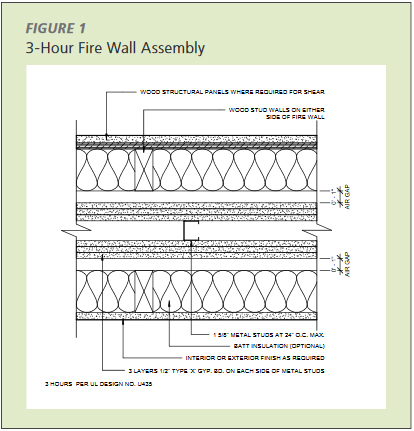
For Type V construction, fire walls are permitted to be of combustible material and require two-hour fire-resistance rating. In addition to tested assemblies, opportunities exist under the NFPA 221 Standard for High Challenge Fire Walls, Fire Walls and Fire Barrier Walls, where designers may build a two-hour-rated fire wall using two contiguous one-hour fire resistance-rated assemblies. This may make sense at double party wall locations.
TABLE 4
| Table 706.4 • Fire Wall Fire-Resistence Ratings | |
|---|---|
| Group | Fire-Resistance Rating (Hours) |
| A, B, E, H-4, I, R-1, R-2, U | 3a |
| F-1, H-3b, H-5, M, S-1 | 3 |
| H-1, H-2 | 4b |
| F-2, S-2, R-3, R-4 | 2 |
aIn Type II or V construction, walls shall be permitted to have a 2-hour fire-resistance rating. bFor Group H-1, H-2 or H-3 buildings, also see Sections 415.6 and 415.7. Source: 2012 IBC.
Fire ratings for fire walls are based on occupancy per Table 706.4. Structural engineers must also recognize the other requirements of Section 706, which include requirements for stability of the fire wall in order to isolate any potential structural collapse to just one side of the fire wall. This is typically achieved using a double wall system so the structure for each side of the building is independent.
Details and Fire Rating of Floor-to-Wall Intersections
The fire rating of an exterior wall assembly in Type III construction causes a detailing issue where the floor intersects the exterior wall assembly. There are no testing criteria established by the code for system intersections of any material, so detailing must rely on code interpretation. The two points of interpretation focus on continuity of the two-hour wall fire rating and the FRT requirement.
Section 705.6 requires that an exterior wall have "sufficient structural stability such that it will remain in place for the duration of time indicated by the required fire resistance rating." The 'interruption' of the floor in the plane of the exterior wall may be seen by authorities as affecting the structural stability. It is not clear how designers are to comply with this language; as such, this wording has been removed in the 2015 IBC.
The implication of FRT continuity is derived from the primary requirement that Type III buildings have noncombustible exterior walls. As discussed, FRT wood is permitted in these walls per IBC Sections 602.3 and 602.4. Since the non-combustibility or acceptable FRT alternative is intended to reduce fire exposure to other buildings, some code officials require FRT material in the plane of exterior walls through the floor intersection. The degree to which a building official believes that the rim joist, floor joist and/or sheathing present a risk of fire spread will determine the degree of FRT material required through the floor-wall intersection.
The manner in which this floor-to-wall connection can be detailed first depends on the type of framing being used—traditional platform framing or semi/modified balloon framing. Platform framing relies on the fact that the floor system bears directly onto the wall below. Semi-balloon framing relies on hangars to support the floor framing.
Typical platform-framed floor-to-wall intersections have been accepted by many jurisdictions without any special detailing using the rationale that the area of intersection represents "floor framing" and not "wall framing." In these intersections, the "floor" is not required to be FRT and its fire resistance is limited to one hour. This is similar to the floor conditions found in Type V construction; as such, it is logical to extend the same detailing allowances at this intersection to Type III buildings.
While local code interpretation varies widely, a variety of detailing concepts have arisen across the country as possible solutions to this issue.
In Figure 2, for example, a solid sawn, glulam or engineered rim board is used to create continuity of the two-hour rating through the plane of the wall by using the charring capability of the rim board calculated using Chapter 16 of the NDS. Variations of this detail include a built-up rim board. In some solutions, the member closest on the outside of the wall may also be FRT to provide some degree of FRT continuity. If continuity of FRT through the floor for the entire width of the wall is also required, the entire thickened rim board and possibly the first sheet of floor sheathing may need to be FRT. In some scenarios without heavy FRT requirements, a hanger is not needed if the rim board width that can accommodate the charring is narrower than the width of the wall and the joist can bear on the stud itself.
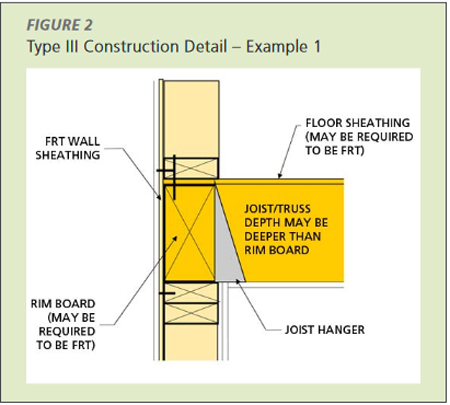
Figure 3 illustrates another option—i.e., using a continuous 2x block to achieve one hour of fire resistance, again calculated using Chapter 16 of the NDS. The second hour of resistance is provided by the horizontally-applied drywall on the underside of the floor. While the two layers of drywall may not be in the plane of the wall, there are still two hours of fire endurance provided. This detail may or may not require that the block and the floor sheathing be FRT, depending on the FRT continuity interpretation. Variations of this detail include an option where the blocking is moved inside the plane of the wall between the joists. Some jurisdictions object, citing concerns about fires starting in the floor cavity. There are other measures, such as fire blocking or cavity sprinklers, provided to minimize spread of fire in these situations. The same question could be asked about fires starting within a wall cavity.
Another option is a slight variation on Figure 3. Instead of using blocking to achieve the one hour of fire resistance, one layer of drywall extends up behind the top flange hanger using a proprietary connector. This provides one hour of fire resistance in the plane of the wall, and the second hour is provided by the drywall on the underside of the floor. Some contractors find this detail difficult to accommodate because of construction sequencing; the drywall crew typically does not arrive on site until after rough framing is complete. A variation seen in some areas is using a top-chord bearing truss, which eliminates the hanger hardware and minimizes the non-treated penetration in the plane of the exterior wall. Addressing full FRT continuity may be more difficult with this variation depending on the truss manufacturer.
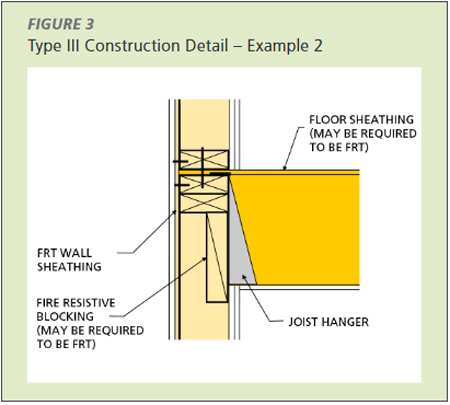
A fourth option requires a relatively new proprietary connector solution that allows two layers of gypsum to be applied behind the joist after floor installation. This solution can add considerable material costs to the framing that could be avoided by some of the other solutions suggested.
In addition to regional nuances and differing (and evolving) code interpretations, there isn't one solution that fits all applications. Designers should determine the local availability of FRT products, review manufacturer product specifications, and discuss the proposed solution with their jurisdiction. (WoodWorks and the American Wood Council offer technical support on this issue, at no cost.)
Balconies
Balconies are commonly used in mid-rise, multi-residential construction. If the balcony framing in a Type III structure is FRT, then the framing is not required to be fire rated in accordance with IBC Section 601 or 602. The code commentary says:
"Because these elements are, in a sense, an extension of floor construction, combustible appendages are required to afford the same required fire-resistance rating as required for floor construction in Table 602, unless the appendage is of FRT or heavy timber construction (Type IV construction). As an additional safeguard against exterior fire spread, the aggregate length of combustible appendages must not exceed 50 percent of the building perimeter on each floor. Balconies, porches, decks, supplemental exterior stairs and similar appendages in buildings of Types I and II construction are required to be constructed of noncombustible materials in order to prevent fire involvement and fire spread up or along the exterior of a noncombustible building. In buildings of Types III, IV and V construction, the use of combustible materials for these elements is permitted."
If the balcony is not FRT, it will be subject to fire protection requirements per IBC Table 601 for floors or Table 602 if rating requirements are higher UNLESS it is Type IV construction or sprinklered.
To summarize, balcony options for construction Types III or V are:
- Noncombustible with no sprinklers and no fire-resistance rating requirements
- FRT framing with no sprinklers and no fire-resistance rating
- Type IV construction with no sprinklers and no fire-resistance rating
- Combustible construction with sprinklers and no fire-resistance rating
- Combustible construction, fire-resistance rated per IBC 601 and 602, and no sprinklers
Cantilevered balconies are also a challenge to detail because they penetrate the plane of the exterior wall assembly. Unique solutions include having a noncombustible structure penetrate the wall assembly, or supporting the balcony by insetting balcony elements into the exterior wall as shown in the photos below. This avoids having cantilevered elements penetrate the exterior wall.
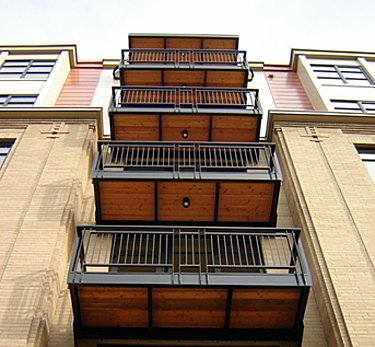
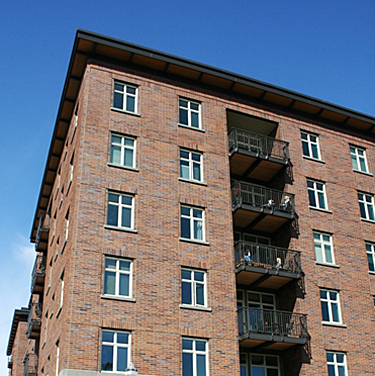
Heavy timber decking used on balcony Photo credit: Scott Nyseth, Stonewood Engineering
Balcony elements inset to exterior walls Photo credit: Scott Nyseth, Stonewood Engineering
Shrinkage
When lumber is initially harvested, its moisture content (MC) is relatively high compared to its eventual in-service equilibrium moisture content (EMC). As the wood dries from its original moist, 'green' state to the in-service equilibrium state, it shrinks. This shrinkage must be accounted for in wood buildings over three stories in height per IBC 2304.3.3.
For softwood species commonly used as structural lumber, wood shrinks by approximately 4 percent radially (across growth rings) and by approximately 8 percent tangentially (around growth rings) from the fiber saturation point to its oven dry state. Shrinkage due to drying in the longitudinal direction is much less and commonly assumed insignificant. When a log is manufactured into lumber the radial and tangential directions of the growth rings end up being oriented randomly within the thickness and depth of a board. Therefore, an average radial and tangential shrinkage coefficient of 0.0020 per inch per every 1 percent change in MC is suggested for shrinkage of the thickness and depth of most softwood lumber (Western Wood Products Association 2002).
Ideally, if a building was framed with lumber with an MC equal to the average EMC, only slight seasonal shrinkage would occur after construction. However, this rarely occurs. Surfaced green lumber, commonly stamped S-GRN, has an MC greater than 19 percent at the time of manufacture. Dry lumber, including surfaced dry (S-DRY), kiln dried (KD) and kiln dried and heat treated (KD HT), has a maximum MC of 19 percent at the time of manufacture. Less common is MC 15 or KD 15 with a maximum MC of 15 percent at the time of manufacture. Further, the MC of lumber when the framing is being closed into finished walls can vary significantly from the MC at the time of manufacture. For shrinkage-sensitive projects (e.g., when a detail or finish material has a very small range of flexibility for differential movement), specifying the MC of lumber at close-in may be a prudent decision. However, regional availability should be a consideration.
Practically speaking, the first source of wood shrinkage to consider is cross-grain shrinkage of load bearing members. These are load bearing sills, plates and rim boards where the gravity loads are applied perpendicular to the face of the members. By considering cross-grain shrinkage or minimizing the cross-grain orientation of members in the load path, much of the potential shrinkage in a mid-rise building can be avoided.
In Type III and V construction, a common framing style for mid-rise construction is traditional platform framing of each level of floor framing with a rim board resting on the top plates of the load bearing stud walls below. This style of construction has benefits in both cost and speed of construction; however, the cross-grain shrinkage of the floor framing and rim boards accumulates over the height of the building. Using balloon or modified balloon framing has the floor framing hanging from the top plate of the bearing walls. This style of framing isolates the movement in the floors from the walls, thus preventing its participation in overall building height change. However, while this may address shrinkage issues, it introduces the need for more connection hardware.
The difference in total shrinkage between platform and modified balloon framing can be significant. Consider an example where the MC changes from 19 percent at time of construction to a 9 percent EMC. The shrinkage ratio to apply to horizontal members in the vertical load path is 0.002 (9 to 19 percent) = -0.02. This shrinkage ratio would then be applied to the depth of all plate, floor and rim board members in the exterior wall assembly of the building or floor level being considered.
- For platform framing using three 2x plates per story and a 12-inch nominal rim per floor, shrinkage over five stories will be approximately 1.4 inches.
- For modified balloon framing using three 2x plates per story, shrinkage will be approximately 0.45 inches.
The predicted amount of shrinkage can have significant impacts on detailing of the overturning resistance components of the lateral system, exterior finish, and mechanical/electrical/plumbing considerations.
Conclusions
Although wood-frame construction has long been a cost-effective choice for low-rise buildings, a growing number of designers are expanding its use in mid-rise projects and maximizing wood's potential for increased density. As this page illustrates, designers can go beyond the base heights and areas permitted for wood-frame structures by utilizing building code provisions related to fire protection (e.g., the addition of NFPA 13-compliant sprinkler systems and open frontage) and building configuration (e.g., podiums and mezzanines). However, the key to success lies in understanding the additional design challenges that arise when increasing the height and area of wood buildings and the use of effective detailing.
Relevant Codes and Standards
- 2012 International Building Code, International Code Council
- ASCE 7-10 Minimum Design Loads for Buildings and Other Structures
- ASTM E119 Standard Test Methods for Fire Tests of Building Construction and Materials
- Code Conforming Wood Design, 2012, American Wood Council
- Design for Code Acceptance 4: Component Additive Method for Calculating and Demonstrating Assembly Fire EnduranceDownload AWC-DCA4-CAM-1007.pdf , 2010, American Wood Council
- National Design Specification (NDS) for Wood Construction, 2012, American Wood Council
- NFPA 13, Standard for the Installation of Sprinkler Systems
- NFPA 13R, Standard for the Installation of Sprinkler Systems in Low-Rise Residential Occupancies
- Shrinkage Calculations for Multistory Wood Frame Construction, Tech Notes Report No. 10Download WWPA%20Shrinkage%20TN10.pdf , Western Wood Products Association, 2002
- UL 263 Standard for Fire Tests of Building Construction and Materials
For more information, the U.S. WoodWorks program offers free one-on-one technical assistance as well as a wide range of online resources (www.woodworks.org). For assistance with a project, email help@woodworks.org or visit www.woodworks.org/project-assistance-map.
End Notes
i [For information and references supporting attributes of wood such as cost effectiveness and sustainability, visit OnlineDownload why-wood]
ii [The International Residential Code is typically not used for the design of mid-rise structures. It is intended for single-family homes, duplexes and townhomes three stories or less in height.]




